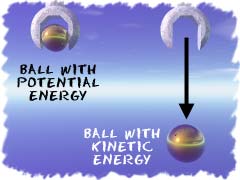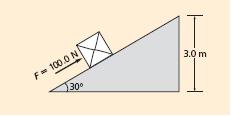In this unit, we have studied different forms of energy and the measures of work and power. We did a lab to find out how work and power are related, and that was really helpful when energy came into play because all three of these ideas are intertwined. We learned that kinetic energy, the energy of movement, is different than potential energy, but both are equal to work and are all measured in Joules. Towards the end of the unit, we touched on the conservation of energy which was a nice refresher about how the conservation of momentum works. Seeing similarities between these two topics made it easier to understand the purpose of the conservation of energy.
 The first topic we discussed was work. Work is equal to (force)(time), and is measured in Joules. Next, we learned that power is the time in which work is done, and is measured in watts. In the lab we did where we walked, ran, and walked with weights up three flights of stairs, we were able to calculate our weight in joules, the work we did, and the amount of power it took. Through the course of this year, I think that this has been the best hands on experience of physics. Although I have been able to recognize it in my daily life, the lab helped me better understand the topic of work and power.
The first topic we discussed was work. Work is equal to (force)(time), and is measured in Joules. Next, we learned that power is the time in which work is done, and is measured in watts. In the lab we did where we walked, ran, and walked with weights up three flights of stairs, we were able to calculate our weight in joules, the work we did, and the amount of power it took. Through the course of this year, I think that this has been the best hands on experience of physics. Although I have been able to recognize it in my daily life, the lab helped me better understand the topic of work and power.To help myself review, I made a Quizlet with the formulas I needed.
work= (f)(d) :joules
power= work/time :watts

1 horsepower= 746 watts
After we were comfortable with the concept of work, we brought in kinetic energy, which is the energy of movement. Obviously a resting object cannot have kinetic energy, but all objects do have potential energy. In the example we often used in class, a ball is resting on the top of the cliff, where it only has potential energy. However, just before it hits the ground, it has the same amount of energy, but it is now kinetic since it is moving. An imperative concept to grasp is that an object's potential and kinetic energy values are equal no matter which type it is. So if the ball has 2,000J of potential energy at the top, it still has 2,000J of energy during it's fall, but it is now kinetic.
Kinetic energy= 1/2mv^2 :joules
potential energy= mgh :joules
Change in pe=work=change in ke
 As I said earlier, a good refresher from a past unit was the reintroduction of the conservation of momentum and how it is similar to what we recently learned, the conservation of energy. In a machine, which I will get to later, energy is mostly conserved while only a small amount of energy is lost through heat or sound. An important formula to know when talking about the conservation of energy is that the work in=work out of a machine. We know that work=(f)(d), and because of the law of conservation of energy, the work in must equal the work out. A common misconception is that all machines are 100% efficient, but as I said earlier, some energy is lost due to heat and sound. In the example of a ramp that is 2m in vertical height and 8m in length, we want to push a 600N box up the ramp. Using the formula work in = work out, we can plug in these numbers to find out how much force was needed to push the box up the ramp.
As I said earlier, a good refresher from a past unit was the reintroduction of the conservation of momentum and how it is similar to what we recently learned, the conservation of energy. In a machine, which I will get to later, energy is mostly conserved while only a small amount of energy is lost through heat or sound. An important formula to know when talking about the conservation of energy is that the work in=work out of a machine. We know that work=(f)(d), and because of the law of conservation of energy, the work in must equal the work out. A common misconception is that all machines are 100% efficient, but as I said earlier, some energy is lost due to heat and sound. In the example of a ramp that is 2m in vertical height and 8m in length, we want to push a 600N box up the ramp. Using the formula work in = work out, we can plug in these numbers to find out how much force was needed to push the box up the ramp.Work in = work out
(f)(d) = (f)(d)
600(2) = (f)(8)
1200=f8
150N=f
Key formulas to know for this topic are:
Work in = work out
Change in PE= change in KE
Lastly, after we understood the conservation of energy, we applied our knowledge to simple machines such as ramps, pulleys, and jacks. The formula used in the previous topic, work in = work out, is vital to understanding how simple machines help us. The main goal of a machine is to decrease either the force or the distance, but not the work as a whole. In the ramp example, the factors for work in are the weight of the box and the vertical height, and the factors for work out are the length of the ramp and the unknown force.
By writing this blog, I have made connections that I hadn't before between topics and also it helped me to solidify my prior knowledge of some information. It was helpful to list the different formulas and also bold the key words so that I will remember what the unit was really about, and not get caught up in the specifics as I have in the past.

Hi Caroline! I really enjoyed your video, (although I thought it was weird we had the same topic and used the same song :0...) and I liked how you drew out the diagrams and explained it in lots of detail. I also love how you highlight the key words on your blog to make them easier to find! Overall, your blog is awesome and I love the pictures and how you explain the concepts. The only thing I could think of to make this even better would be adding examples for the other types of simple machines. Great job, Caroline!
ReplyDelete